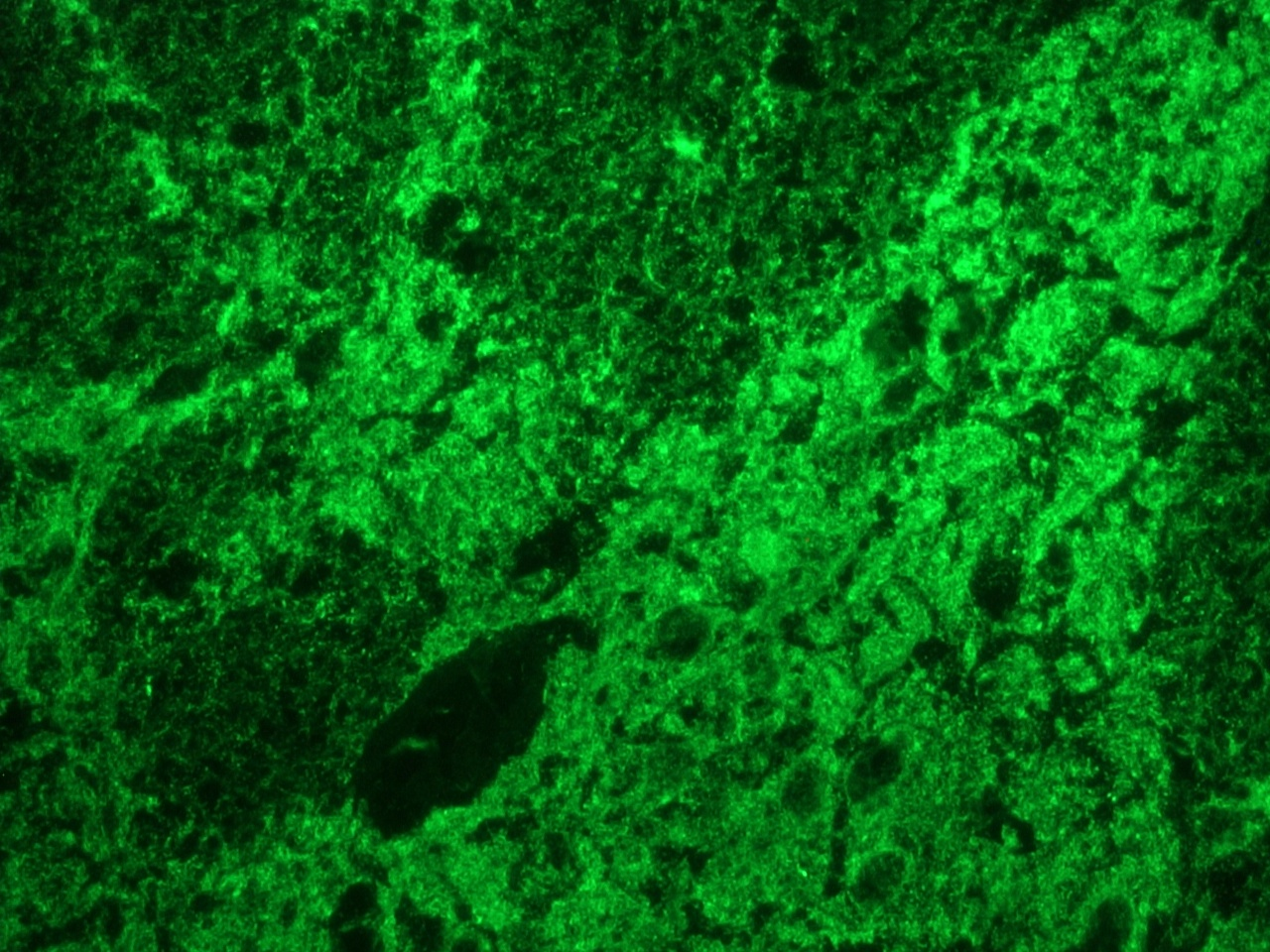Catalogue

Mouse anti Reticulon-1C / NSP-C
Catalog number: MUB1315P| Clone | RNL-4 |
| Isotype | IgG1 |
| Product Type |
Primary Antibodies |
| Units | 0.1 mg |
| Host | Mouse |
| Species Reactivity |
Human Rat Swine |
| Application |
Flow Cytometry Immunocytochemistry Immunohistochemistry (frozen) Western Blotting |
Background
Recently, a novel gene family has been identified and characterized, designated the Reticulons because the proteins encoded by these genes are anchored to the membranes of the endoplasmic reticulum. Reticulon-1 was formerly designated NSP for Neuroendocrine-Specific-Protein, because it is specifically expressed in neural and neuroendocrine tissues. The NSP-gene has been mapped by fluorescence in situ hybridization to Human chromosome 14q21-q22. The NSP-gene encodes three overlapping proteins, i.e. Reticulon-1A (NSP-A), Reticulon-1B (NSP-B), and Reticulon-1C (NSP-C). These proteins were found to be anchored to membranes of the endoplasmic reticulum through their common carboxy-terminal regions. Reticulon-1A is a protein with a molecular weight (MW) of about 135 kDa, which occurs in various isoforms presumably depending on the degree of phosphorylation of serine residues. In lung cancer diagnosis Reticulon-1A appeared to be a reliable marker for the detection of neuroendocrine differentiation, since most of the small cell lung carcinoma (SCLC) and carcinoid tumors showed expression of Reticulon-1A. Reticulon-1B is a phosphoprotein with a MW of 45 kDa and is restricted to the lung cancer cell line NCI-H82. Reticulon-1B is sofar not found in Human tissues. Reticulon-1C is a protein with a MW of 23 kDa which is not phosphorylated and is found with Reticulon-1A in SCLC (cell lines) and not in non-SCLC (cell cultures).
Synonyms: Reticulon/ Neuro-endocrine specific protein
Source
RNL-4 is a Mouse monoclonal IgG1 antibody derived by fusion of SP2/0-Ag14 Mouse myeloma cells, with spleen cells from a BALB/c Mouse immunized with a synthetic peptide encompassing the unique 20 N-terminal amino acid sequence of Reticulon-1C.
Product
Each vial contains 100 ul 1 mg/ml purified monoclonal antibody in PBS containing 0.09% sodium azide.
Formulation: Each vial contains 100 ul 1 mg/ml purified monoclonal antibody in PBS containing 0.09% sodium azide.
Specificity
RNL-4 recognizes an epitope loCated within the first 20 amino acids of Reticulon-1C (NSP-C). RNL-4 reacts with peripheral nerves and ganglia of various tissues and cross-reacts with smooth muscle cells and myoepithelium. In the central nervous system it reacts with the neurohypophysis and pars intermedia of the pituitary gland, and a weak diffuse staining was observed in neurons of the granular and molecular layer of the cerebellar cortex, while glial cells, cerebellar medulla and Purkinje cells are negative. Reticulon-1 has been found to indiCate neuronal differentiation and to be downregulated in neurological pathologies.
Applications
RNL-4 is useful for immunocytochemistry, immunohistochemistry on frozen tissues, immunoblotting and flow cytometry. Optimal antibody dilution should be determined by titration; recommended range is 1:50 – 1:100 for flow cytometry, and for immunohistochemistry with avidin-biotinylated Horseradish peroxidase complex (ABC) as detection reagent, and 1:100 – 1:500 for immunoblotting applications.
Storage
The antibody is shipped at ambient temperature and may be stored at +4°C. For prolonged storage prepare appropriate aliquots and store at or below -20°C. Prior to use, an aliquot is thawed slowly in the dark at ambient temperature, spun down again and used to prepare working dilutions by adding sterile phosphate buffered saline (PBS, pH 7.2). Repeated thawing and freezing should be avoided. Working dilutions should be stored at +4°C, not refrozen, and preferably used the same day. If a slight precipitation occurs upon storage, this should be removed by centrifugation. It will not affect the performance or the concentration of the product.
Caution
This product is intended FOR RESEARCH USE ONLY, and FOR TESTS IN VITRO, not for use in diagnostic or therapeutic procedures involving humans or animals. It may contain hazardous ingredients. Please refer to the Safety Data Sheets (SDS) for additional information and proper handling procedures. Dispose product remainders according to local regulations.This datasheet is as accurate as reasonably achievable, but Nordic-MUbio accepts no liability for any inaccuracies or omissions in this information.
References
1. Senden, N. H., Timmer, E. D., Boers, J. E., van de Velde, H. J., Roebroek, A. J., Van de Ven, W. J., Broers, J. L., and Ramaekers, F. C. (1996). Neuroendocrine-specific protein C (NSP-C): subcellular localization and differential expression in relation to NSP-A, Eur J Cell Biol 69, 197-213.
2. Senden, N. H., Timmer, E. D., de Bruine, A., Wagenaar, S. S., Van de Velde, H. J., Roebroek, A. J., Van de Ven, W. J., Broers, J. L., and Ramaekers, F. C. (1997). A comparison of NSP-reticulons with conventional neuroendocrine markers in immunophenotyping of lung cancers, J Pathol 182, 13-21.
3. Hens, J., Nuydens, R., Geerts, H., Senden, N. H., Van de Ven, W. J., Roebroek, A. J., van de Velde, H. J., Ramaekers, F. C., and Broers, J. L. (1998). Neuronal differentiation is accompanied by NSP-C expression, Cell Tissue Res 292, 229-37.
4. Kim, S. H., Yoo, B. C., Broers, J. L., Cairns, N., and Lubec, G. (2000). Neuroendocrine-specific protein C, a marker of neuronal differentiation, is reduced in brain of patients with Down syndrome and Alzheimer's disease, Biochem Biophys Res Commun 276, 329-34.
Safety Datasheet(s) for this product:
| NM_Sodium Azide |

Figure 1. Indirect immunofluorescence staining of reticulon-1C (NSP-C) in frozen tissue section of rat brain using MUB1315P (RNL-4; diluted 1:1000).

Figure 2. Indirect immunofluorescence staining of reticulon-1C (NSP-C) in frozen tissue section of rat brain using MUB1315P (RNL-4; diluted 1:1000).


